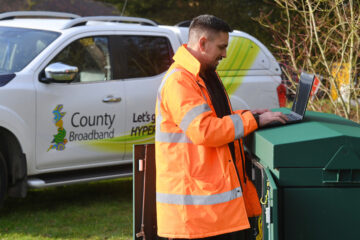A new report has revealed a mixed picture for the East of England with Norfolk and Suffolk falling behind in the UK league table for access to full fibre broadband whilst Essex and Cambridgeshire surge ahead.
The UK as a whole has passed the halfway mark for full fibre availability with 52% of premises (15.4 million) having access to the technology.
However, just 41% of homes in South Norfolk can access the technology, equating to 27,826 premises whilst the figure for North Norfolk is only 15% (9,428 premises). It’s a similar picture across Suffolk with Mid Suffolk achieving 41% (20,888 premises) and East Suffolk at 42% (54,416 premises) although West Suffolk is slightly ahead with full fibre available to 54% of homes (46,925 premises).
The findings are more positive for Cambridgeshire with East Cambridgeshire at 64% (26,706 premises) and Cambridge out in front at 75% (45,895 premises). However, South Cambridgeshire has fallen behind at only 42% (31,511 premises).
Essex faces a more mixed bag with Colchester significantly behind with just 28% full fibre access (24,743 premises) but Maldon and Braintree achieving nearly double at 71% (21,964 premises) and 60% (43,575 premises) respectively.

The Connected Nations report, published by Ofcom, is based on findings from April and May 2023. Whilst it’s the first time UK full fibre access has passed the 50% threshold, around 62,000 premises are still unable to access ‘decent’ broadband which is defined as download speeds of at least 10 Mbps and upload speeds above 1 Mbps.
The government has committed to achieving nationwide full fibre broadband coverage by 2030. The new report highlighted the rollout of full fibre broadband was ‘supported by a number of smaller providers across the UK serving individual communities and regions’.
One such provider is County Broadband which is building new full fibre broadband networks in over 250 villages across the East of England, focusing on rural and hard to reach areas, and is backed by a £146 million of private investment from Aviva Investors.
Responding to the new Ofcom Connected Nations report, James Salmon, Director of Corporate Development at County Broadband, said: “It’s positive to see the UK as a whole has reached the 50% full fibre milestone but it’s clear there are significant regional variations.
“Whilst the East of England certainly isn’t in the full fibre relegation zone, it’s a real mixed bag of results on the national league table. Homes and businesses will be well aware of the postcode lottery when it comes to decent broadband access, which for many is now the fourth utility.
“The importance of reliable connectivity for remote work, entertainment and accessing vital services from healthcare to education is well known. The average speed that customers can achieve across the UK now stands at 94Mbps which is faster than the existing copper networks can deliver.

“Building full fibre broadband networks is essential to futureproof homes and businesses but rural communities have historically been overlooked by the national providers, often due to the cost or logistical challenges of connecting them.
“That’s why we’re focussed on building our networks in rural villages to ensure these communities are not left behind. We’re continuing to accelerate our rollout in response to growing demand to give the East of England a boost on the national league table.”
Full fibre broadband uses fibre-to-the-premises (FTTP) infrastructure where fibre optic cables are installed directly into premises to deliver faster and more reliable download and upload speeds of up to 1,000 Mbps. This is 11x faster than the existing Superfast networks which rely on copper cables and the government has said are no longer fit for purpose.
Residents and businesses can check if they are covered in County Broadband’s rollout by entering their postcode at www.countybroadband.co.uk where they can also register their interest in finding out more about the service.





